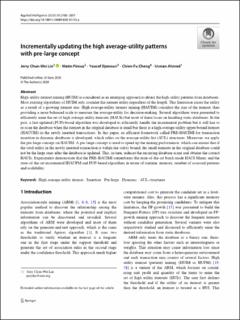| dc.contributor.author | Lin, Jerry Chun-Wei | |
| dc.contributor.author | Pirouz, Matin | |
| dc.contributor.author | Djenouri, Youcef | |
| dc.contributor.author | Cheng, Chien-Fu | |
| dc.contributor.author | Ahmed, Usman | |
| dc.date.accessioned | 2020-12-22T10:20:11Z | |
| dc.date.available | 2020-12-22T10:20:11Z | |
| dc.date.created | 2020-11-02T18:02:56Z | |
| dc.date.issued | 2020 | |
| dc.identifier.citation | Lin, J. C.-W., Pirouz, M., Djenouri, Y., Cheng, C.-F., & Ahmed, U. (2020). Incrementally updating the high average-utility patterns with pre-large concept. Applied Intelligence, 50(11), 3788-3807. | en_US |
| dc.identifier.issn | 0924-669X | |
| dc.identifier.uri | https://hdl.handle.net/11250/2720740 | |
| dc.description.abstract | High-utility itemset mining (HUIM) is considered as an emerging approach to detect the high-utility patterns from databases. Most existing algorithms of HUIM only consider the itemset utility regardless of the length. This limitation raises the utility as a result of a growing itemset size. High average-utility itemset mining (HAUIM) considers the size of the itemset, thus providing a more balanced scale to measure the average-utility for decision-making. Several algorithms were presented to efficiently mine the set of high average-utility itemsets (HAUIs) but most of them focus on handling static databases. In the past, a fast-updated (FUP)-based algorithm was developed to efficiently handle the incremental problem but it still has to re-scan the database when the itemset in the original database is small but there is a high average-utility upper-bound itemset (HAUUBI) in the newly inserted transactions. In this paper, an efficient framework called PRE-HAUIMI for transaction insertion in dynamic databases is developed, which relies on the average-utility-list (AUL) structures. Moreover, we apply the pre-large concept on HAUIM. A pre-large concept is used to speed up the mining performance, which can ensure that if the total utility in the newly inserted transaction is within the safety bound, the small itemsets in the original database could not be the large ones after the database is updated. This, in turn, reduces the recurring database scans and obtains the correct HAUIs. Experiments demonstrate that the PRE-HAUIMI outperforms the state-of-the-art batch mode HAUI-Miner, and the state-of-the-art incremental IHAUPM and FUP-based algorithms in terms of runtime, memory, number of assessed patterns and scalability. | en_US |
| dc.language.iso | eng | en_US |
| dc.rights | Navngivelse 4.0 Internasjonal | * |
| dc.rights.uri | http://creativecommons.org/licenses/by/4.0/deed.no | * |
| dc.subject | High average-utility itemset | en_US |
| dc.subject | Insertion | en_US |
| dc.subject | Pre-large | en_US |
| dc.subject | Dynamic | en_US |
| dc.subject | AUL-structures | en_US |
| dc.title | Incrementally updating the high average-utility patterns with pre-large concept | en_US |
| dc.type | Peer reviewed | en_US |
| dc.type | Journal article | en_US |
| dc.description.version | publishedVersion | en_US |
| dc.rights.holder | © The Author(s) 2020 | en_US |
| dc.source.pagenumber | 3788-3807 | en_US |
| dc.source.volume | 50 | en_US |
| dc.source.journal | Applied intelligence | en_US |
| dc.source.issue | 11 | en_US |
| dc.identifier.doi | 10.1007/s10489-020-01743-y | |
| dc.identifier.cristin | 1844288 | |
| cristin.ispublished | true | |
| cristin.fulltext | original | |
| cristin.qualitycode | 2 | |

